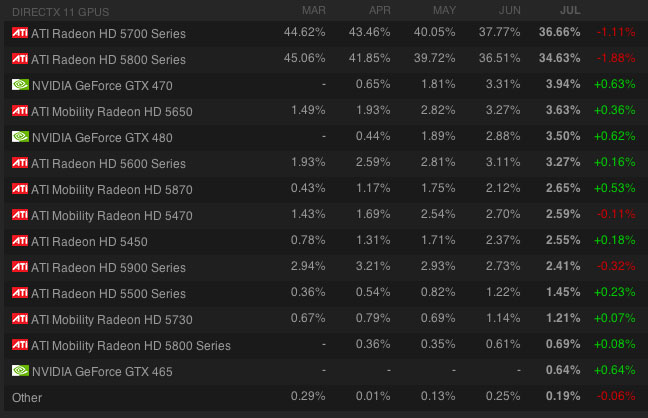ATI Eyefinity Ecosystem - September 2010 Update
During the call, ATI provided some details as to the success of the Radeon HD 5000 series. While everyone loves a good set of numbers, I think there is a greater take-away. The Radeon HD series as been very successful with ATI, and Eyefinity as a unique feature as been a success as well.
This is good news for gamers of all stripes. The more traction that multi-monitor gaming gets from a hardware standpoint, the better support developers will provide in their games. Over the past year we have seen more and more games have better "basic" support for multi-monitor, and I hope the success of Eyefinity points to even better support in the future.
Penetration of HD 5000 Series
 In three quarters, AMD has shipped over 16 million Radeon 5000 SKUs. With each of these supporting Eyefinity, that puts a potentially large user base into the market. Based on these shipments (and the late release of the NVIDIA GTX400 series), ATI now has 51% of the discrete graphics market.
In three quarters, AMD has shipped over 16 million Radeon 5000 SKUs. With each of these supporting Eyefinity, that puts a potentially large user base into the market. Based on these shipments (and the late release of the NVIDIA GTX400 series), ATI now has 51% of the discrete graphics market.
Additionally, looking at the DX11 GPU usage in the Steam Hardware Survey, ATI has a commanding lead with almost 92% of the DX11 install base. ATI obviously jumped out to an early lead in the DX11 space, but NVIDIA will surely begin to recover market share in this newest class with the continued roll-out of its GTX400 series (SKUs like the GTX460 in particular).
However, the leaks around the pending 6000-series should keep things interesting in the GPU leap-frog.
Developer Adoption of Eyefinity
ATI continues to tout growing support of the Eyefinity platform in top tier games. With the release (and continued updating) of the open source Eyefinity SDK, ATI has provided tools to ease developers into supporting Eyefinity and multi-monitor. While much of the much of the SDK is devoted to Eyefinity-specific implementations (based on reading info from an Eyefinity Display Group), the basis of the SDK is universal to any multi-monitor environment. This attitude helps ensure that all gamers benefit from ATI's work, and that no gamers are left without support.
While we've had some disappointments (Mass Effect 2), some games patched late (Bioshock 2), and some games that continue to need fan-made hacks (StarCraft II), ATI has secured strong support from many developers. Support of Eyefinity is a growing trend, and the chart below is a reflection of their current support.

More DP Monitors Available
A year ago DisplayPort monitors were few and far between, and they tended to be larger high-end monitors with matching price tags. Over this past year, DP monitors have become ubiquitous reaching though the upper-end into the mid-range monitors. By way of example, each widescreen monitor in HP's commercial "Advantage" and "Professional" lines has a DisplayPort input. This includes sub-$250 TN models and sub-$300 IPS models. And HP is not alone with this type of DisplayPort adoption, with Dell and Apple offering similar adoption.
AMD Value Proposition
ATI has always billed its Radeon HD 5000 series as a strong value for the price/performance ratio. They made great strides in noise, heat and power consumption over their previous generation, as well as the the offerings from NVIDIA. Eyefinity requires at least one DisplayPort connection, and that adds an inherent cost to the setup as either new monitors or adapters must be purchased.
PC Perspective talked about the price of a multi-monitor setup in their review of NVIDIA 3DVS, and compared the total costs of ATI Eyefinity to NVIDIA 3D Vision Surround (which requires SLI). Lowering the cost of the DisplayPort adapter makes a significant change to the total investment for Eyefinity. Couple this with the mid-range cards released in the last year, and Eyefinity is a significantly better value than it was at launch.
Conclusion & The Future
ATI has done a lot over the last year to promote and improve the value of its Eyefinity platform. Relevant monitors (including IPS monitors) are considerably cheaper, and Active DisplayPort adapters are now significantly cheaper. Mid range cards (HD 5850) are available for under $300, and CrossFireX performance has been solidified so multi-GPU can be had for $500-$600. Add to this that the Radeon 6000-series seems to be around the corner, with the expected HD 6800 SKU performing on par with the HD 5970 multi-GPU card.
I agree with ATI that Eyefinity is a mature platform, and we're about to hit the second generation of the platform with the HD 6000-series. With the newly available Single-Link DVI adapters, the entry price for new Eyefinity users is much lower - as is the potential frustration level. With continued competition with NVIDIA in the multi-monitor space, the future is bright and immersive.